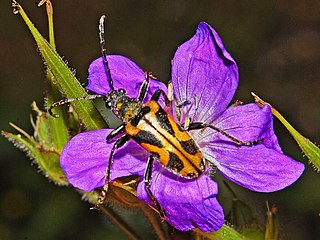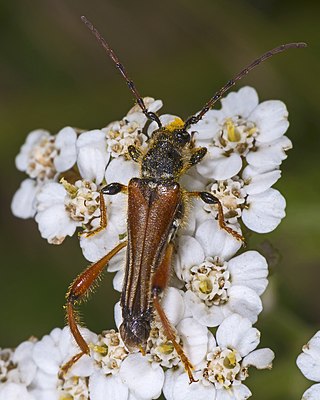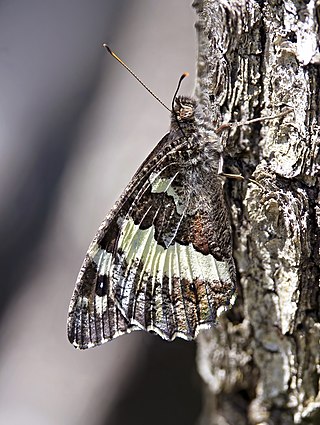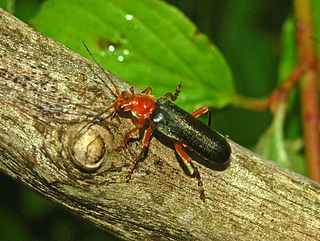
The black arches or nun moth is a small Palaearctic moth. It is considered a forest pest.

Clytus arietis, the wasp beetle, is a wasp-mimicking longhorn beetle species in the genus Clytus.

Volucella bombylans is a large species of hoverfly belonging to the family Syrphidae.

Pandemis cerasana, the barred fruit-tree tortrix, is a moth of the family Tortricidae.

Brachyta interrogationis is the species of the Lepturinae subfamily in long-horned beetle family. This species was described in 1758 by Carl Linnaeus in the 10th edition of Systema Naturae under the name Leptura interrogationis.

Gaurotes virginea is a species of the Lepturinae subfamily in the long-horned beetle family.

Pachyta quadrimaculata is a species of the Lepturinae subfamily in long-horned beetle family.

Asemum striatum, the black spruce borer, is a beetle species belonging to the family Cerambycidae, subfamily Spondylidinae.

Chlorophorus sartor is a species of beetle of the family Cerambycidae, subfamily Cerambycinae.

Clytus rhamni is a species of round-necked longhorns belonging to the family Cerambycidae, subfamily Cerambycinae.

Rutpela maculata, the spotted longhorn, is a beetle species of flower longhorns of the family Cerambycidae, subfamily Lepturinae.

Stenopterus rufus is a beetle species of round-necked longhorns belonging to the family Cerambycidae, subfamily Cerambycinae.

Stenurella melanura is a flower longhorn beetle species of the family Cerambycidae, subfamily Lepturinae.

Brintesia is a monotypic butterfly genus in the family Nymphalidae and subfamily Satyrinae. Its one species is Brintesia circe, the great banded grayling.

Cantharis livida is a species of soldier beetle belonging to the genus Cantharis family Cantharidae.

Anastrangalia dubia is a species of beetle of family Cerambycidae.

Chlorophorus varius, the grape wood borer, is a species of beetle in the family Cerambycidae.

Helophilus fasciatus, the narrow-headed marsh fly, is an abundant species of syrphid fly observed throughout the United States and Canada. Hoverflies can remain nearly motionless in flight. The adults are also known as flower flies for they are commonly found on flowers, from which they get both energy-giving nectar and protein-rich pollen. The larvae of this genus are associated with wet decaying organic material, particularly accumulations of decaying vegetation in ponds and mud and farmyard manure or silage. The adults of this species lays eggs on vegetation overhanging the water. The larvae hatch and drop into the water.

Helophilus lapponicus, the Yellow-margined Marsh Fly, is a common species of syrphid fly observed across northern North America, northern Europe, Greenland and Siberia. Hoverflies can remain nearly motionless in flight. The adults are also known as flower flies for they are commonly found on flowers, from which they get both energy-giving nectar and protein-rich pollen. Though common the larvae of this species are not known but the larvae of other species in this genus are associated with wet decaying organic material, particularly accumulations of decaying vegetation in ponds and mud and are a so called rat-tailed type.

Tragosoma depsarium is a species of longhorn beetle in the family Cerambycidae. It is the only one of its genus in Europe and is found mainly in cool regions of Northern Europe and Siberia, along with the high altitudes of the Alps and other mountain ranges. This beetle typically lives in open and manageable dry forest areas with old trees. Due to the decline of coniferous forests with a corresponding proportion of old wood, the beetle populations are also declining. In some regions of its range, including Germany, Tragosoma depsarium is considered endangered.


























